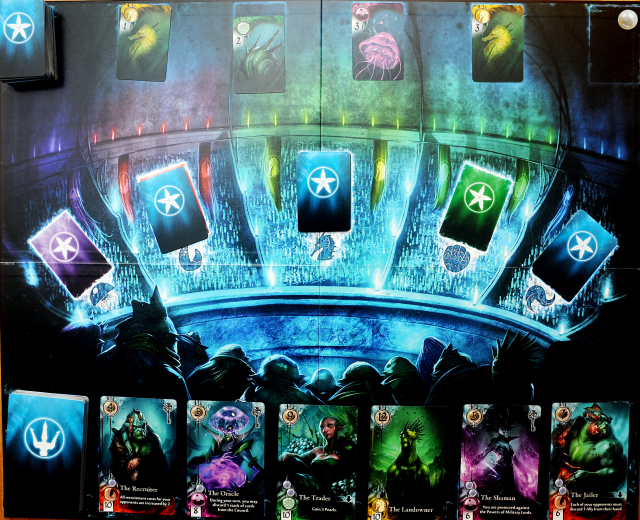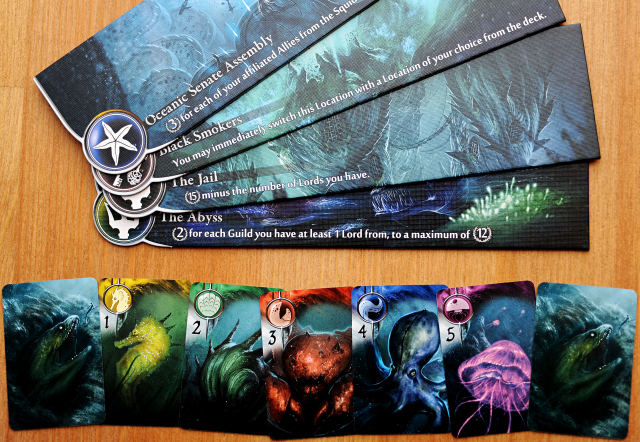Few designers made as big an impact on GenCon 2014 as Bruno Cathala. With seven releases spread across different publishers it might as well have been called Cathala-Con. One of the games that made the biggest impacts was Abyss. This joint design with Charles Chevallier plays 2-4 in about 45 minutes. The rules are simple to pick up, but the depth of strategy will keep engaged for numerous plays.
In Abyss players vie for the vacated throne of the deep sea kingdom. By working with affiliated races, recruiting Lords and controlling locations you can claim power over the entire submerged world of Abyss.

There are six different guilds of Lords to recruit from, the Soldiers, Farmers, Politicians, Mages, Merchants and Ambassadors. Allies can be found in five different flavours. Numbered 1-5 are the Crabs, Seahorses, Jellyfish, Squid and Shellfish. They will cover the cost of recruiting the Lords. Each guild of Lords is associated with a specific group of Allies, requiring at least some of their presence when paying their recruitment cost. Ambassadors, the most diplomatic of the Lords, require a representative from all the Allies groups to be recruited.
Each turn players execute one of three actions.
Exploring the Depths allows players to flip Allies cards in the hopes of finding friends in high places to help with the recruiting of Lords. When each Ally is flipped the other players in clockwise order get the chance to purchase the card from the active player. If they all pass the active player can take the card for free or flip another. If the Ally track is filled the active player must take the last card, but it comes with a Pearl (the currency of the game). When exploring you may also turn up a monster card. When you do you’re faced with an option. You can fight the monster, gaining the reward indicated on the monster track and ending your turn, or you can pass, advance the monster track and continue your turn. This improves the quality of the reward for the next player to come across a monster card. Could be you, could be one of your opponents. Rewards for fighting Monsters include pearls, keys or randomly drawn monster tokens which can value between 2-4. Once the active player has completed their turn, all the Allies not chosen move down to the Council in the pile specified for their race. This leads us to…

Requesting Support from the Council. This second action allows you to choose one race pile of Allies and add them to your hand. It can be a bit of a memory game keeping track of the value of the cards that got passed up on previous rounds, but eventually those stacks will grow and become too tempting to ignore. A well timed stack grab can pad your hand with Allies and allow you to…
Recruit a Lord. Lords have very specific costs to adhere to when you recruit them. You need to spend a minimum value of Allies, usually with one one specific race present and an exact number of additional races. Lords all have an end game point value and often have an instant or on-going ability to help you throughout the course of the game. Lords may also provide Keys which can be used to acquire Locations. When you spend Allies to recruit Lords you keep one of the Allies of the lowest value you spent. These will be counted in end game scoring. At the start of the game there are six Lords available for purchase. When the fourth is bought the track is refilled and the person who made the purchase gains two pearls as a reward.
Locations cost three Keys and are used in end game scoring. They are influenced by either Lords, Allies or other Locations. For example The Dockworks which provides points for each of your Merchant Lords or The Chasm which rewards your Allies from the Crab race. If the Keys on a Lord card are used to buy a Location then that Lord’s power is covered by the Location. It will still be used in end game scoring, but it’s ability is no longer in play.
Game end is triggered when one player has recruited a seventh Lord. Each other player gets one more turn and then is able to add the lowest value Ally they have in hand from each race to the Allies they’ve collected so far. End game scoring involves totalling points for Locations, Lords, Allies and Monster Tokens.
The rules to Abyss are quite simple. It’s a game that’s all about finding scoring synergies between your Allies, Lords and Locations.
I’m just going to go ahead and say that I love this game. The style and weight of Abyss are right in the sweet spot for me. I can build a strategy and make important decisions, but it’s not such a brain burner that it is too tough for newer players to get in to. Add in the beautiful art, components and theme and I’m sold hook, line and sinker. Abyss is easily my pick for the best game that I played at GenCon and even my best game game of 2014 so far. Do yourself a favour and give this one a try!
[…] its beauty and ease of play, Abyss has gone a bit under the radar in the gaming world. You don’t hear a ton of discussion on it. It […]